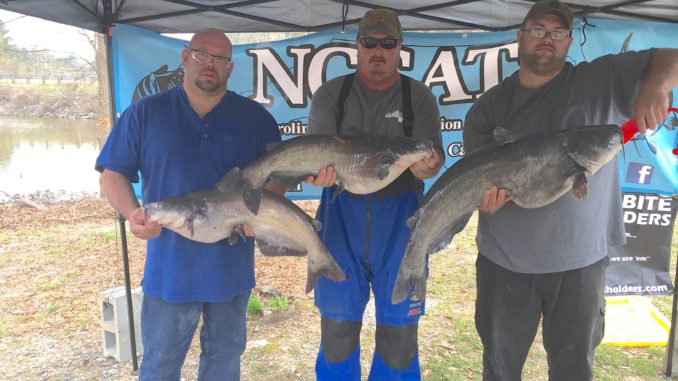
Small reservoir offers big fishing
When Kevin Custer of the N.C. Catfish Tournament Association Series was asked to name a productive lake for big blue catfish in the winter, he didn’t say Lake Norman or Badin Lake as many people might expect. Instead, he chose Lake Tillery, one of the smaller impoundments of the Yadkin-Pee Dee River system.
Custer, who is from Statesville, N.C., said finding winter blues is easier at Tillery because its big catfish are largely confined to the upper section of the lake where the Uwharrie River empties into Tillery — the spot where the Yadkin River becomes the Pee Dee.
“The lake narrows in the river section, and the channel averages about 5 or 6 feet in depth with a rugged, rocky bottom, making it ideal living quarters for blue cats,” Custer said. “When I drop anchor, I can feel the anchor bang against the rocks before taking hold.”
Custer searches for holes 11 feet deep along the river section. He said that’s where the big blues live.
Because of the river’s narrow confines, fishermen can easily locate deep holes with their electronics, plus, there’s no need to motor long distances in the winter cold.
Once Custer locates a deep hole, he drops anchor and sets out a spread of rods around his boat. He uses heavy tackle, spooling his reel with 35-pound monofilament and slides a flat, 3/8-ounce tear drop-shaped sinker on to the line.
He ties the end of the line to a leader through a barrel swivel to begin the makings of a Carolina rig. The rig consists of a leader up to 24 inches long that’s formed by doubling 35-pound monofilament to make it stronger and more abrasion-resistant to the rocky bottom. A No. 8/0 circle hook tied to the end of the leader completes the rig.
Custer runs the hook through the eyeballs of the head section of a cut gizzard shad or through the sides of the midsection piece.
“I never use the tail section of the shad, because there’s not enough there to entice a big catfish to bite,” said Custer.
He adds an in-line float to the leader several inches above the hook to keep the bait off the bottom.
Cluster said the river section of Tillery usually has plenty of forage to attract fish, but the fishing is better when water released through the dam produces a steady current.
The best fishing conditions include a cloudy cover, little or no wind, water temperatures in the 40s and current.
“The blues run from 5 to 15 pounds, but there’s always a good chance of catching a fish weighing 40 pounds,” Custer said.



